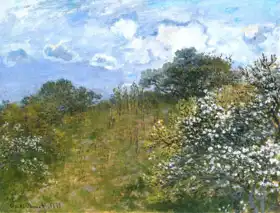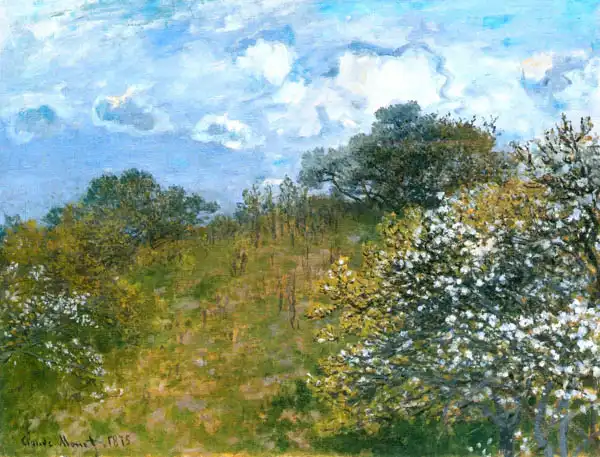Spring
Date:
1875Medium:
oil on canvasLocation:
Johannesburg Art Gallery, South AfricaDimensions:
60.5 x 81"Spring" (originally "Le Printemps") is an oil painting created by the famous French Impressionist painter
Claude Monet around 1872. The painting depicts a spring scene in Monet's garden at Argenteuil, which was a favorite location for many of his
Impressionist works.
In the painting "Spring" we see beautiful blooming trees and
flowers that enliven the landscape after a long winter. Monet's technique includes soft brush strokes and shades of green and various pastel colors, creating the impression of freshness and refreshment that spring brings. Impressionists like Monet were known for trying to capture the effects of light and atmosphere at different times of the day and year, and "Spring" is an excellent example of this effort.
This painting is also significant in that it shows Monet's love of nature and his ability to capture the beauty of everyday life. At the same time, the Impressionists were influenced by the development of photography, which led to their efforts to capture moments and atmosphere in the real world. Monet's work is a symbol of this effort and his contribution to the development of the Impressionist style.
Claude Monet's "Spring" is among his many works that are now exhibited in museums and galleries around the world and are very popular among art lovers.
Monet painted picture Spring in 1875. Prevailing color of this fine art print is green and its shape is landscape. Original size is 60.5 x 81. This art piece is located in Johannesburg Art Gallery, South Africa. This image is printed on demand - you can choose material, size and finishing.
Claude Oscar Monet (1840-1926). A native Parisian, who thoroughly developed the idea of
Impressionism. Monet almost scientifically studied the effect of light on different objects. He devoted himself to so called transitory states, which quickly led him to work with colour and light, his paintings acting on the viewer from the first impression. His use of open-air painting and objects which were special only because of light opened the way for the beginnings of modern painting. Monet’s
Impression, Sunrise (1874) not only gave the name to the whole art movement, but secured Monet a place among the best painters of all times. At one time, he resided in London and created his famous study
Houses of Parliament (Monet wondered, How could the English painters paint Parliament when it cannot be seen for the fog?). In the
Giverny, which became his favourite retreat after the death of his wife, he painted motifs from his garden and the popular series
Water Lilies - the world of the water was as poetic and mysterious as a primordial paradise.


